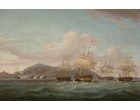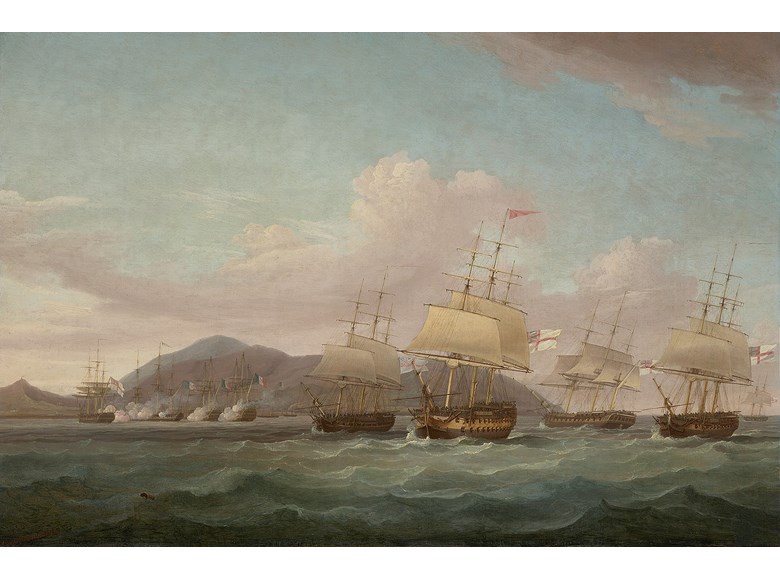 BACK TO GALLERY
BACK TO GALLERY
Rountree Tryon Galleries
Thomas Whitcombe
The raid on Saint Paul, Reunion, September 1809
26 x 39 in. (66 x 99 cm) 32 1/2 x 45 1/2 in. (82.6 x 115.6 cm) framed
description
Thomas Whitcombe (1752-1824)
The raid on Saint Paul, Reunion, September 1809
oil on canvas
signed and dated 'T. Whitcombe 1813' (lower left)
26 x 39 in. (66 x 99 cm)
32 1/2 x 45 1/2 in. (82.6 x 115.6 cm) framed
Provenance:
with The Parker Gallery, London.
This painting records the British attack on the port of St. Paul on the French island Reunion in the Indian Ocean during the Napoleonic Wars. The event is seen as a forerunner to the later British invasion of the island in 1810 and was an opportunity to capture the French frigate Caroline and two East Indiamen she had seized during a skirmish in the Bay of Bengal on 31st May.
Having taken aboard a force of a few hundred soldiers commanded by Lt. Col. Henry Keating at the island of Rodrigues, Sir Josias Rowley, Captain of HMS Reasonable, feinted towards Mauritius, then dashed westward to Reunion. The main port of St. Paul, protected by 125 pieces of artillery, was too formidable to be approached directly from the sea. On September 21st, Rowley put the soldiers ashore about seven miles west of the town. They were accompanied by a landing force of sailors and Marines led by Commander Willoughby. Keating marched rapidly overland and took the French artillery batteries against light opposition, opening the way for Rowley to bring his ships into the harbour.
In this painting, Rowley’s Reasonable (right of centre) and other ships of his squadron are depicted in the foreground, while in the harbour in the bay of St. Paul beyond, HMS Sirius can be seen engaging with the French frigate Caroline and her two East Indiamen prizes. The dramatic landscape of Reunion sits in the background with French forts identifiable to the left.
The attack was only a raid, intended to discomfort the French, Caroline and other ships were captured and the East Indiamen Streatham and Europe recovered. Although the defences of St. Paul had been overcome with little resistance, strong French land forces were reported elsewhere on the island and were expected to counterattack. A more rash commander might have tried to turn the raid into a full-fledged conquest and occupation, but Rowley decided that the risks of further action without reinforcements were too great. Having temporarily disabled the French artillery defences by "spiking" the cannons, the British boarded their ships and sailed away.
Whitcombe created other records of the event - a very similar version to the present work dated 1812 is held in the National Maritime Museum collection in Greenwich and another more detailed painting of the action between Sirius and Caroline, also dated 1812, was previously handled by the gallery.
The raid on Saint Paul, Reunion, September 1809
oil on canvas
signed and dated 'T. Whitcombe 1813' (lower left)
26 x 39 in. (66 x 99 cm)
32 1/2 x 45 1/2 in. (82.6 x 115.6 cm) framed
Provenance:
with The Parker Gallery, London.
This painting records the British attack on the port of St. Paul on the French island Reunion in the Indian Ocean during the Napoleonic Wars. The event is seen as a forerunner to the later British invasion of the island in 1810 and was an opportunity to capture the French frigate Caroline and two East Indiamen she had seized during a skirmish in the Bay of Bengal on 31st May.
Having taken aboard a force of a few hundred soldiers commanded by Lt. Col. Henry Keating at the island of Rodrigues, Sir Josias Rowley, Captain of HMS Reasonable, feinted towards Mauritius, then dashed westward to Reunion. The main port of St. Paul, protected by 125 pieces of artillery, was too formidable to be approached directly from the sea. On September 21st, Rowley put the soldiers ashore about seven miles west of the town. They were accompanied by a landing force of sailors and Marines led by Commander Willoughby. Keating marched rapidly overland and took the French artillery batteries against light opposition, opening the way for Rowley to bring his ships into the harbour.
In this painting, Rowley’s Reasonable (right of centre) and other ships of his squadron are depicted in the foreground, while in the harbour in the bay of St. Paul beyond, HMS Sirius can be seen engaging with the French frigate Caroline and her two East Indiamen prizes. The dramatic landscape of Reunion sits in the background with French forts identifiable to the left.
The attack was only a raid, intended to discomfort the French, Caroline and other ships were captured and the East Indiamen Streatham and Europe recovered. Although the defences of St. Paul had been overcome with little resistance, strong French land forces were reported elsewhere on the island and were expected to counterattack. A more rash commander might have tried to turn the raid into a full-fledged conquest and occupation, but Rowley decided that the risks of further action without reinforcements were too great. Having temporarily disabled the French artillery defences by "spiking" the cannons, the British boarded their ships and sailed away.
Whitcombe created other records of the event - a very similar version to the present work dated 1812 is held in the National Maritime Museum collection in Greenwich and another more detailed painting of the action between Sirius and Caroline, also dated 1812, was previously handled by the gallery.






 SEND AN EMAIL
SEND AN EMAIL
 +441798344207
+441798344207